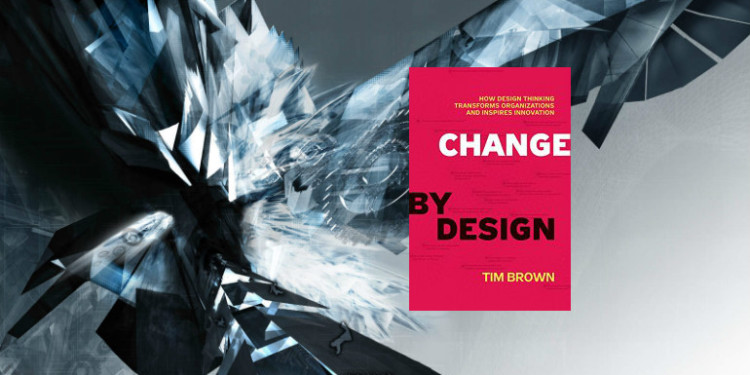Design Thinking

Design thinking is a method for transformation and value creation that can be applied to business, the environment, and human needs. When applied to large scale issues, design thinking can create solutions that go beyond aesthetics, usability, and profit.
In Change by Design, Tim Brown, CEO of IDEO, illustrates how integrative, systems thinking can bring more powerful and wide ranging benefits than are typically associated with the design discipline. Using a human-centered approach, prototypes, storytelling, and a focus on experiences, design thinking emphasizes holistic solutions rather than incremental improvements to consumer objects.
I was trained as an industrial designer, but it took me a long time to realize the difference between being a designer and thinking like a designer. Seven years of undergraduate and graduate education and fifteen years of professional practice went by before I had any real inkling that what I was doing was more than simply a link in a chain that connected a client’s engineering department to the folks upstairs in marketing…Only gradually did I come to see the power of design not as a link in a chain but as the hub of a wheel.
The power of design thinking
The power of design thinking comes from its human-centered orientation and participatory nature. By connecting with the lives, behaviors, aspirations, and needs of the people it serves, design thinking begins with a solid foundation for creativity and problem solving. For Brown, design thinking starts with human needs, uses prototyping as its journey, and participation as its destination. Participatory design creates “many more forms of value than cash” because it involves, empowers, and takes into consideration many viewpoints.
By integrating what is desirable from a human point of view with what is technologically feasible and economically viable, designers have been able to create the products we enjoy today. Design thinking takes the next step, which is to put these tools into the hands of people who may have never thought of themselves as designers and apply them to a vastly greater range of problems…The evolution from design to design thinking is the story of the evolution from the creation of products to the analysis of the relationship between people and products, and from there to the relationship between people and people.
Brown uses Isambard Kingdom Brunel as an example of an early design thinker. Brunel designed the Great Western Railway and had a vision of creating an experience of floating across the countryside. To create this experience he engineered flat gradients, viaducts, and tunnels that were part of a larger plan for an integrated travel system linking London to New York via trains and ships. Brunel designed a transportation experience with a system-wide view in mind to create more than just a railway journey.
Embracing constraints
The willing and even enthusiastic acceptance of competing constraints is the foundation of design thinking…Constraints can best be visualized in terms of three overlapping criteria for successful ideas: feasibility (what is functionally possible within the foreseeable future); viability (what is likely to become part of a sustainable business model); and desirability (what makes sense to people and for people)… A competent designer will resolve each of these three constraints, but a design thinker will bring them into a harmonious balance.
Constraints are a mirror of the real world in which a design will operate and provide benefit. Keeping all three dimensions of constraints in mind enables the design team to balance the needs of the business, with that of the end user and broader community. Starting a design project with just a single attribute in mind can lead to incremental solutions that do not add significant or lasting value.
Asking the right questions
Posing questions which are aspirational yet specific enough to guide creativity is an essential starting point for design thinking. Brown gives many examples in the book of “how might we?” questions which energize brainstorming. Asking a question that is too specific in a design brief narrows the range of value a solution can provide. Conversely, asking too broad of a question doesn’t provide sufficient constraints to create a solution that meets a defined need. Since design projects frequently begin with a design brief, it’s important to ask questions that will stimulate design thinking instead of merely incremental improvement.
Discovering demand
The basic problem is that people are so ingenious at adapting to inconvenient situations that they are often not even aware that they are doing… The tools of conventional market research can be useful in pointing toward incremental improvements, but they will never lead to those rule-breaking, game-changing, paradigm-shifting breakthroughs that leave us scratching our heads and wondering why nobody ever thought of them before. Our real goal, then, is not so much fulfilling manifest needs by creating a speedier printer or a more ergonomic keyboard; that’s the job of designers. It is helping people to articulate the latent needs they may not even know they have, and this is the challenge of design thinkers.
Brown believes that traditional focus groups or user interviews only yield incremental improvements because the people who are using a current solution or are immersed in a current context are not aware of all the workarounds and augmentations they have made to overcome usability and functional issues. Brown is a proponent of working with the “most extreme users” in the design process because people who are pushing the boundaries of objects and systems frequently expose new opportunities that mainstream uses do not. He believes that there is a huge opportunity in edge cases where there is little interest from large companies.
Integrative thinking
The process of the design thinker, rather, looks like a rhythmic exchange between the divergent and convergent phases, with each subsequent iteration less broad and more detailed than the previous ones. In the divergent phase, new options emerge. In the convergent phase it is just the reverse: now it’s time to eliminate options and make choices. It can be painful to let a once-promising idea fall away, and this is where the diplomatic skills of project leaders are often tested.
Design thinking brings together both synthetic and analytic approaches along with divergent and convergent thinking. Because integrative thinking is the “ability to exploit opposing ideas and opposing constraints to create new solutions”, it is a cornerstone of design thinking. Much of management training is focused on making decisions and converging on a final outcome. Design thinking adds a divergent phase which is used to generate options through brainstorming and other creative techniques. Pairing the two phases creates a cycle of ideation and selection through which new ideas are generated and identified for implementation. Exploration of alternatives and derivative ideas is encouraged by the cycle between synthetic and analytic thinking.
Prototyping
Prototyping, or “thinking with your hands”, is a key element of the design thinking method. Brown suggests time to first prototype as a success metric for projects. Prototyping is participatory, supports learning, and encourages continual improvement through iteration. Prototypes get the conversation going and get everyone’s hands on the end product. Large scale prototypes can model environments; services can be prototyped through role playing and narrative. There is a balance to successful prototyping–over investing in an early prototype can stop creativity in its tracks as the team stops divergent thinking and gets into implementation mode.
Designing experiences
Considering the experience of a product, service, system, or environment enables the design thinker to provide more satisfying solutions which address more than just technical or functional requirements. Effective brand and relationship building relies on engagement and participation, which are hallmarks of design thinking techniques. Experience design puts the design team in the shoes of their end users and puts a human focus on the end solution. The experience of a product or service is also a broader canvas on which to create and provides more opportunities for adding value. Experiences also tend to emphasize relationships between people, not just people and objects. That creates a more challenging problem domain, but also creates more opportunity for break-out value.
Brown says “a real experience culture is a culture of spontaneity” because great experiences cannot be scripted nor can they be documented via a process. Narrative and storytelling become important here because the essence of the experience is the journey that the customer takes. Connecting and understanding the emotional elements of an experience are essential for the design team to create a new and more satisfying one.
In the video below, Tim Brown talks about “moving from design to design thinking” and touches on many of the themes from Change by Design.
Based on his early experiences designing objects that quickly became obsolete, Brown says the impact of design has been diminished because it has transformed from “systems thinkers who are reinventing the world to a priesthood of folks in black turtlenecks and designer glasses who are working on small things.” He observes that over time “design became a profession and focused on an ever smaller canvas until it came to stand for aesthetics, image, and fashion” rather than working on transformative issues such as global warming, education, healthcare, security, and clean water. Brown observes that “maybe what passed for design wasn’t all that important–making things more attractive, easier to use, and more marketable.” For him, design thinking is the path towards solving much larger, longer lasting, and more valuable problems. Brown says “design has its greatest impact when it is taken out of the hands of designers and put into the hands of everyone”.






